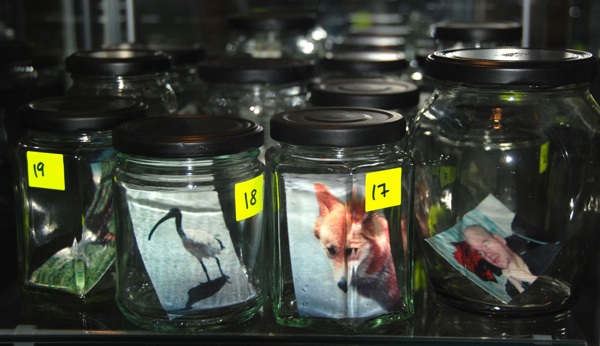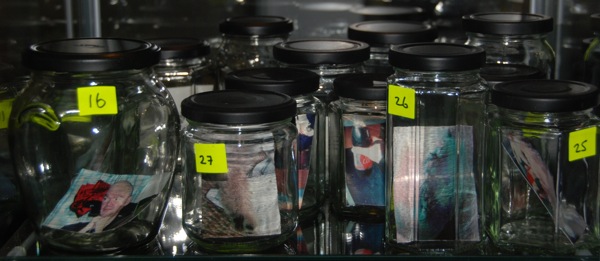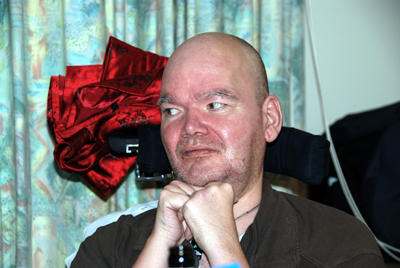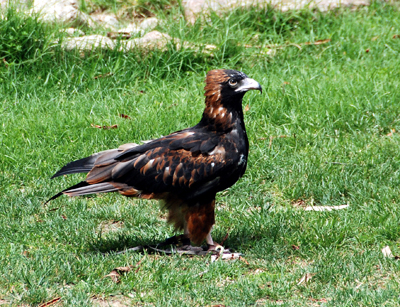|
Memory Jar Collection 2

16) David's head and hands
January 2009
This shows my friend, the late David Morris, when we were staying at Holton Lee in January 2009. David's friends joked that his head was like a frog's, and consequently he collected frog memorabilia. He held regular salons at his flat in Limehouse, and posted videos on Youtube of him singing with his friends under the name the Limehouse Frogs.
David's hands were the only part of him that he was able to move a little by himself. When his hand was placed on his wheelchair or on his computer switch system by someone else, he could move his fingers slightly to control these. When he wasn't doing that, though, he usually asked his PA to put his hands into this position when he was sitting in his wheelchair. This, then, is how I will always remember him. David usually wore numerous bangles on both wrists, but this image was taken when we were sitting around one evening in our nightclothes.
As well as being a very skilled artist, David was an expert politician - when he died, he was the Mayor of London's Disability Adviser, but had been seconded to lead on external inclusion for the 2012 Olympics and Paralympic. He had a hand in things all over the world.
17) Dingo's head
Autumn 2009
This dingo lives at the Healesville Sanctuary in Victoria, Australia, and I met him and his sibling when I was in the country to talk about the Abnormal exhibition themes as a keynote speaker at the Australian Network of Arts and Technology's Super Human: Revolution of the Species symposium. (You can click here to read my presentation). I could not believe how beautiful and shy dingos are; they are wild dogs who originally came over from Asia. You would never recognise this head from reading all of the descriptions of dingos as yellow, snarling animals best hunted and destroyed. Clearly the real issue is that they compete for water and food with the grazing animals that were imported from Europe, and in the case of sheep, presumably also prey on them.
18) Australian bird/shadow
Autumn 2009
This bird came up to our cafe table at the Healesville Sanctuary in Victoria, Australia, when I was in the country to talk about the Abnormal exhibition themes as a keynote speaker at the Australian Network of Arts and Technology's Super Human: Revolution of the Species symposium. (You can click here to read my presentation). Wherever it went around the table, it created a shadow conjoined twin.
19) Australian eagle's feet
Autumn 2009
This eagle was being shown as part of a birds of prey display at the Healesville Sanctuary in Victoria, Australia, when I was in the country to talk about the Abnormal exhibition themes as a keynote speaker at the Australian Network of Arts and Technology's Super Human: Revolution of the Species symposium. (You can click here to read my presentation). He completely refused to cooperate with his handler and fly, walking around self-importantly instead all over the enclosure. Much to the frustration of the handler, it was the highlight of the display!
20) Genie's bottom
Xmas 2009
Genie has the most expressive bottom of any dog I know as she swaggers self-importantly around. She is one of the few Westies ever to be trained as an assistance dog (by Dog Aid), although we have never taken the actual exams. In order that she can see me to take instructions, she has to walk slightly in front of me when I am out in my chair or scooter. (I find it hard to turn my head left because of my spinal problems, and my field of vision is also limited by the fact that I wear glasses and am extremely short-sighted.) This stops her from following behind me in strict pack order, which is what the 'heel' position usually accomplishes. In any case, nothing would damage her sense of self - I chose her carefully so that she wouldn't be intimidated by the demands of my job. Part of her training is being able to remove my wallet, phone and keys from my bag and fetch them to me, and this only builds on her natural desire to search the bag of every visitor to the house. We therefore put her Xmas presents into this stocking so she had the fun of removing them for herself.
21) Martyn's and Sarah's fingers
13 February 2010
These two images show my brother and his new wife wearing their wedding rings shortly after the marriage ceremony in Dedham, Essex. The rings symbolise the joining of their bodies and souls, so the images are preserved in the same jar. It was a second marriage for both of them, with both of their previous marriages having ended against their will. Hopefully this marriage will bring them everything that they want in a relationship for the rest of their lives.
22) Horrible hand
Midnight, 6 May 2010
I collected this hand on the way home from my friend David Morris's funeral, which took place on the same day as the General Election. I'd been out most of the day, having left the house at 8am to help set up for the service at Mile End Eco Centre. The Centre had never held a funeral before and had none of the necessary equipment, so I was running the service from my laptop and projector as well as organising the sound etc. I'd returned briefly after the burial to change my shirt, and then gone over to the Hackney venue where I was co-organising the wake. This went on until 11pm. I was almost home with my PA Shola driving when a road contractor stepped out in the street and prevented us from turning into my estate, putting down a bollard in front of us. I tried to explain politely that we needed to pass, and didn't know how we could get home otherwise, but he didn't care or listen. I tried to explain that I had been out all day at a funeral, and was sorry if we were doing something wrong by stopping, as he claimed, but I just needed to get home and couldn't see an alternative route. He didn't care. 'We are the kings here. Talk to the hand, cos the face ain't listening.' Eventually we managed to persuade his boss to let us pass. After we parked, Shola's husband, who had travelled back separately with my partner a few hundred yards in front of us, had to carry me to the front door. I just had no energy left in my own body.
23) Children's hands
July 2010
These children were taking part in a folk-dance summer school in Canning Town run by East London Dance. The school was part of a project to celebrate the unique multi-cultural history of Canning Town where I have been based for the past 25 years - you can read more about it on my Canning Town Folk website.
24) Lucy's head
Xmas 2010
Lucy is a cross between a spaniel and a collie - a sprolly - and came to live with Kathy and Maggie in Brighton in autumn 2010. Kathy and Maggie have always been dog lovers, and their last dog was a pure-bred collie, Bertha. After Bertha died, they shared the custody of Millie, my partner's foster dog (they were old friends of my partner's), and gave Millie a wonderful time. Despite being vegetarians, they cooked her organic chicken daily; got up at the crack of dawn to walk her in Brighton's Preston Park before work; and regularly took her to swim in the sea (where Kathy always had to carry her into the water!). Millie even managed to persuade them to let her sleep on their bed, and to overlook her habit of chewing the bed linen so that it regularly needed replacing. After Millie died, they couldn't decide whether to get a spaniel or collie next: Lucy was the ideal solution!
25) Genie's tummy
January 2011
This is my Westie Genie asleep in her basket at my partner's house; a basket that used to belong to Millie. Now, more often than not, it is occupied by Morgan when we are back at home. Unlike many dogs, Genie is not terribly keen on having her tummy rubbed, but likes to sleep on her back. Genie is very fond of cuddly toys - we trained her to retrieve by attaching various cuddly toy keyrings to objects such as my mobile phone and wallet - and one of her toys is in the basket with her, making the photograph confusing as to what is animal and what toy.
26) Genie's leg
March 2011
In July 2010, at the age of ten and a half, my Westie Genie went lame in her back right knee. Apparently West Highland White Terriers, her 'breed', have knee caps which are too shallow due to interbreeding, and the instability of the knee cap can also damage the ligament. Initially Genie was treated with medication, which was ineffective, and was recommended by the vet to use complementary therapies, which I rejected on the grounds of cost. Surgery was discussed, but not recommended until more time had passed. In December 2010, though, I decided to proceed with surgery, as Genie's knee was no better. The insurance cover would run out 12 months after the onset of her condition, so any operation would have to take place during the following six months. Initially we were referred to a surgical centre in West London, where a surgeon offered to reshape the knee joint completely. This carried a small risk of the leg losing the blood supply and having to be amputated, but in any case the remaining insurance was not enough to cover the costs in full and I could not afford to meet the shortfall. I then took Genie to the RSCPA hospital at Harmondsworth, who offered to operate and attempt to tighten up the ligaments, but really felt that any surgical intervention should have been carried out months earlier. Eventually a South African vet at my own practice offered to carry out a procedure where an artificial ligament was implanted alongside the existing ligament, and I went ahead with this. The vet removed a large flap of cartilage at the same time, in addition to two non-malignant lumps on Genie's neck. The operation was highly successful, and although Genie is now a relatively elderly dog and also has arthritis in both back legs (and probably elsewhere), she is as mobile as I could hope for in the circumstances. It is a shame that, while foreign vets often have experience of carrying out specialist animal surgeries, in the UK this is reserved for consultants who are often unaffordable for pet owners.
27) Bob's leg
March 2011
Bob is a long-haired tabby and white cat who used to live in my partner's garden. When my partner moved into her new home in 2007, she discovered that her upstairs neighbour fed a range of stray cats daily. Their flats are situated next to a bus garage and close to a park, while the main road with all of its restaurants and takeaways is close by, all of which attract cats. However, the East End of London has many stray and feral cats, so competition for food is still fierce. The neighbour died of an asbestos-related lung cancer in December 2009, although she had never worked with asbestos herself. After that, my partner took over the feeding in her memory. Two cats in particular were regulars, and my partner called these Bob Cat and Ginger Cat. In March 2011, after a long hard winter, both cats rapidly deteriorated, presumably having lost their regular shelter. Eventually, we decided that we would capture them and take them to the vet, and then look after one each until they were better and we could see if they preferred to stay indoors or outside - in which case we would build a kennel or other shelter for them in the garden. We trapped the cats on the same day that my Westie Genie had her operation. This photograph, taken that night when I was giving him a sponge bath, shows how dirty Bob's paws had become in his search for food and shelter.
28) Sue's hair
April 2011
The actor Susan Harrison often works as my assistant between jobs. Her last major job before this photograph was taken was starring in Bagpuss at the Soho Theatre over the Xmas holidays. For this job she had to dye her naturally red hair black, and ever since she had been repeatedly washing it to try to get rid of the dye. It was only in April that it finally began to return to normal. Here we were returning from Glasgow, where we had been the guests of Sharmanka Kinetic Theatre company at the party to celebrate their 15th birthday. The reason we were invited was that I had recently worked with one of their sculptures, Sputnik, in a residency at Croydon Clocktower organised by Fittings Multimedia Arts. As part of the residency I had made a film, Fellow Traveller, which was shown at the party. In the summer, Sue starred in Bagpuss again, this time at the Edinburgh Festival, but was then allowed to wear a wig.
29 & 30) Ju's hand (stretching)
April 2011
As a wheelchair user, it is always problematic to travel by train, mostly because the carriages are designed with steps rather than ramps despite all of the travellers who would benefit from step-free access (older people, mothers with pushchairs and everyone with heavy luggage). There are very few spaces for wheelchair users on the trains too - usually two or three at most, situated by the door for 'easy' access. Mindful that wheelchairs are often too high to fit under standard-height tables, the designers of the new Virgin trains have created raised tables next to the wheelchair spaces. However, in order to avoid tipping over backwards during the journey, it is necessary to back your chair right up against the wall at the end of the carriage. Unfortunately, as these photographs show, it is then impossible to be able to reach the table, regardless of its height. This is even more of a problem in first class, as the second photograph shows. It is a shame that designers do not test their designs first.
Click here to view the next shelf of Memory Jars
Click here to return to the start of the catalogue

© Ju Gosling aka ju90 2011
| Funded by the |
 |


